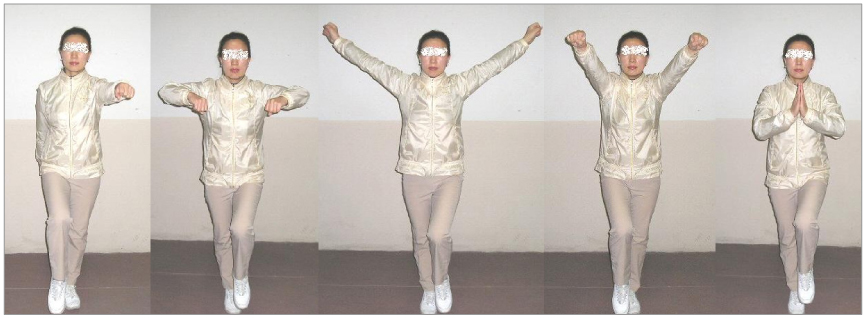J Korean Acad Community Health Nurs.
2012 Mar;23(1):22-30. 10.12799/jkachn.2012.23.1.22.
The Effects of an Aerobic Exercise Program on Mobility, Fall Efficacy, Balance, and Stress in the Elderly at Senior Centers
- Affiliations
-
- 1College of Nursing, Eulji University, Seongnam, Korea.
- 2College of Nursing, Yonsei University, Seoul, Korea.
- 3Department of Nursing, Daebul University, Yeongam, Korea. janghryu@hanmail.net
- KMID: 2292814
- DOI: http://doi.org/10.12799/jkachn.2012.23.1.22
Abstract
- PURPOSE
This study was conducted in order to investigate the effects of an aerobic exercise program on mobility, fall efficacy, balance, and stress in the elderly at senior centers.
METHODS
This research was conducted as a quasi-experimental pretest and posttest control and experimental comparison study. The subjects were 41 senior residents (Exp.=18, Cont.=23) who aged above 65 at senior centers in S City. The period of time for data collection and intervention was from August 25 to December 5, 2008.
RESULTS
Mobility (t=-3.10, p<.01) in the experimental group were significantly higher than those in the control group without an aerobic exercise program. However, fall efficacy (t=1.28, p=.207), balance (t=-.53, p=.602; t=.36, p=.723), stress (t=-1.32, p=.199) in the experimental group was not significantly higher than that in the control group.
CONCLUSION
These findings confirmed that aerobic exercise programs make a contribution to improving mobility in the elderly at senior centers.
MeSH Terms
Figure
Reference
-
1. Choi MA, Kang HS, Kang HS, Gu MO, Kim KS, Kim IJ, et al. Tools to measure exercise effects. 2008. Seoul: Koonja Publishing Company.2. Chu SK, Yoo JH. The effects of perceived stress on cognition in the community elderly. J Korean Acad Community Health Nurs. 2008. 19:368–377.3. Gu MO, Kang YS, Kim ES, Ahn HL, Oh HS, Eun Y. The evaluation of a health promotion program for the community resident older adults. J Korean Acad Nurs. 2002. 32:384–394.
Article4. Han SS, Hyun KS, Kim WO, Won JS, Kim KB. The effects of a health promotion program forelderly. J Korean Acad Nurs. 2005. 35:1054–1062.5. Jung SH, Chung KH. The effects of aerobic exercise therapy on physical functions in the elderly. J Korean Acad Nurs. 2010. 21:252–262.
Article6. Kim ML, Chen HJ. The effects of dance sports activity on self-esteem, stress, and depression in the elderly females. J Korean Phys Edu Assoc Girls Women. 2009. 23:15–27.7. Kim SJ. The effects of ball exercise on the blood lipid, stress hormones and mental health among aged persons with physical disabilities elderly. Educ J Phys Mult Disabl. 2010. 53(4):105–125.8. Kim TI, Lee KY, Park YI, Jeon MH, Kim IJ, Kim EJ, et al. The effects of exercise program for the elderly. J Korean Acad Community Health Nurs. 2006. 17:335–345.9. Laurin D, Verreault R, Lindsay J, MacPherson K, Rockwood K. Physical activity and risk of cognitive impairment and dementia in elderly persons. Arch Neurol. 2001. 58:498–504.
Article10. Lazarus RS, Folkman S. Stress, appraisal and coping. 1984. New York: Spring.11. Lee IS, Chin YR, Lee DO, Kim YA, Baek KA. Effect of rhythmic exercise program to elderly on risk factors of fall injury. J Korean Acad Community Health Nurs. 2001. 12:600–608.12. Lee SJ. An application effect of rhythmic movement program for the health promotion in the elderly. J Korean Acad Nurs. 2000. 30:776–790.
Article13. Lee YJ, Kim TH. A study on the buffering effect of social support on the stress of the elderly who lives alone. J Korea Gerontol Soc. 1999. 19(3):79–93.14. Lee HY, Lee KJ. Effects of tai chi exercise in elderly with knee osteoarthritis. J Korean Acad Nurs. 2008. 38:11–18.
Article15. Methias S, Nayak US, Isaacs B. Balance in the elderly patient: The "get-up and go" test. Arch Phys Med Rehabil. 1986. 67:387–389.16. Mo SH, Lee JY. A study on the stress and the coping behavior of the elderly. J Korea Gerontol Soc. 2002. 22:65–80.17. Nam MR, Kim YH, Ahn OH, Yang BS. The effects of a low intensity exercise program on psychosocial factors of exercise and physical factors in elderly women. J Korean Acad Community Health Nurs. 2007. 18:373–381.18. Ross MC, Bohannon AS, Davis DC, Gurchiek L. The effects of a short-term exercise program on movement, pain, and mood in the elderly. Results of a pilot study. J Holist Nurs. 1999. 17:139–147.19. Seo HM. A study on the stressors and perceived stress level of the elderly. 1996. Seoul: Seoul National University;Unpublished master's thesis.20. Statistics Korea. 2011 Senior statistics. 2011. Retrieved November 1, 2011. from http://www.kosis.kr/ups/ups_ 02List01.jsp?kor_id=0&pubcode=KO&type=F.21. Sung KW. Content analysis of exercise programs for the elderly in Korean and foreign articles. J Korean Acad Community Health Nurs. 2007. 18:56–68.22. Tinetti ME, Richman D, Powell L. Falls efficacy as a measure of fear of falling. J Gerontol. 1990. 45(6):239–243.
Article23. Vanitallie TB. Stress: A risk factor for serious illness. Metabolism. 2002. 51:40–45.
Article24. Yoon HH. The stress, coping behavior, and psychological well-being of seniors. 1994. Seoul: Sookmyung Women's University;Unpublished master's thesis.
- Full Text Links
- Actions
-
Cited
- CITED
-
- Close
- Share
- Similar articles
-
- The Effects of an Aerobic Exercise Program on Mobility, Fall Efficacy, Balance, and Stress in the Elderly at Senior Centers
- Effects of BeHaS Exercise Program on Pain, Balance and Fall Efficacy in Elderly with Osteoarthritis
- The Relationship between Health Belief and Exercise Compliance among Elderly Adults at Senior Centers
- Effect of Seniorobic Program on Physical Function and Fall in Elderly
- Experience of Falls and Predictors of Falls in the Elderly at Senior Citizens' Centers


